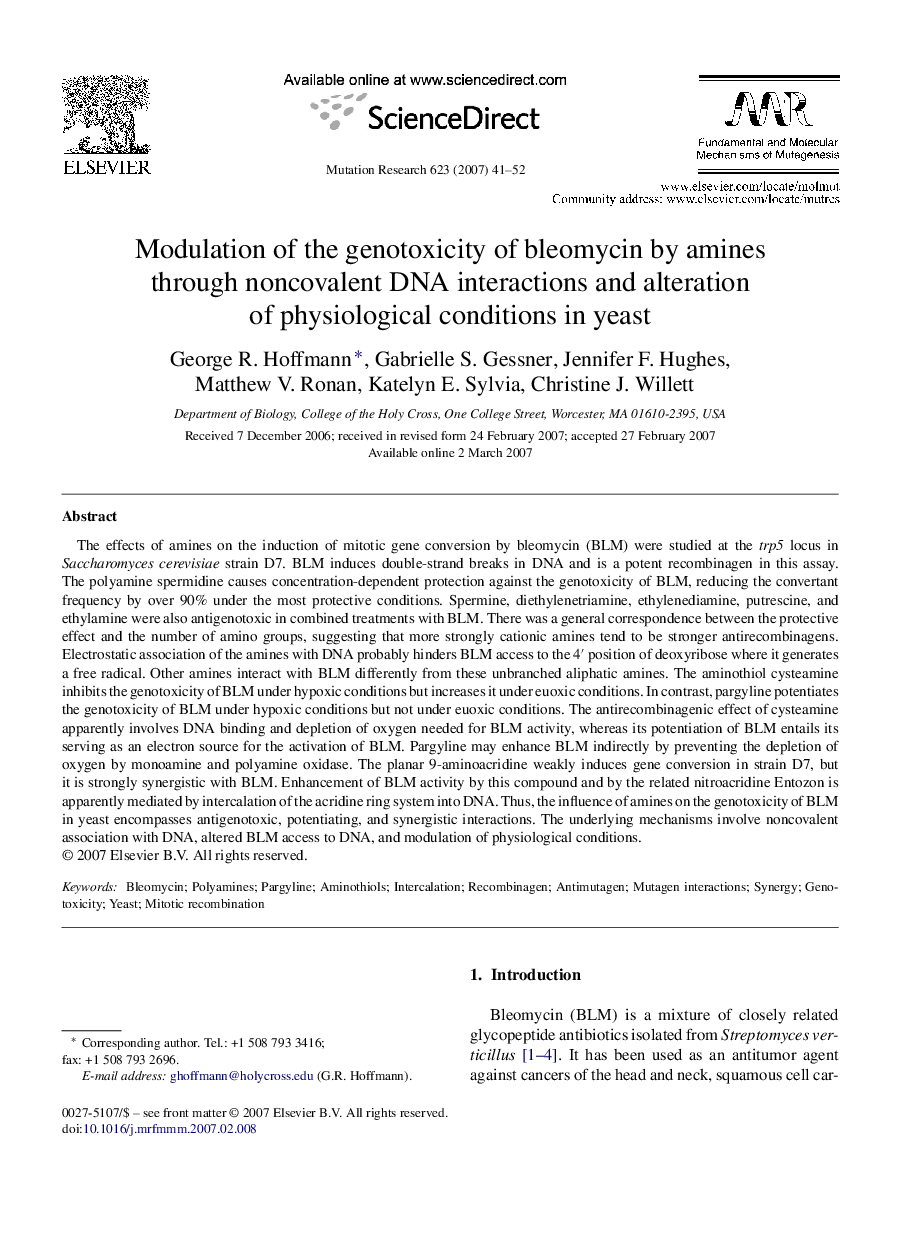| کد مقاله | کد نشریه | سال انتشار | مقاله انگلیسی | نسخه تمام متن |
|---|---|---|---|---|
| 2147289 | 1548406 | 2007 | 12 صفحه PDF | دانلود رایگان |
عنوان انگلیسی مقاله ISI
Modulation of the genotoxicity of bleomycin by amines through noncovalent DNA interactions and alteration of physiological conditions in yeast
دانلود مقاله + سفارش ترجمه
دانلود مقاله ISI انگلیسی
رایگان برای ایرانیان
کلمات کلیدی
موضوعات مرتبط
علوم زیستی و بیوفناوری
بیوشیمی، ژنتیک و زیست شناسی مولکولی
تحقیقات سرطان
پیش نمایش صفحه اول مقاله

چکیده انگلیسی
The effects of amines on the induction of mitotic gene conversion by bleomycin (BLM) were studied at the trp5 locus in Saccharomyces cerevisiae strain D7. BLM induces double-strand breaks in DNA and is a potent recombinagen in this assay. The polyamine spermidine causes concentration-dependent protection against the genotoxicity of BLM, reducing the convertant frequency by over 90% under the most protective conditions. Spermine, diethylenetriamine, ethylenediamine, putrescine, and ethylamine were also antigenotoxic in combined treatments with BLM. There was a general correspondence between the protective effect and the number of amino groups, suggesting that more strongly cationic amines tend to be stronger antirecombinagens. Electrostatic association of the amines with DNA probably hinders BLM access to the 4â² position of deoxyribose where it generates a free radical. Other amines interact with BLM differently from these unbranched aliphatic amines. The aminothiol cysteamine inhibits the genotoxicity of BLM under hypoxic conditions but increases it under euoxic conditions. In contrast, pargyline potentiates the genotoxicity of BLM under hypoxic conditions but not under euoxic conditions. The antirecombinagenic effect of cysteamine apparently involves DNA binding and depletion of oxygen needed for BLM activity, whereas its potentiation of BLM entails its serving as an electron source for the activation of BLM. Pargyline may enhance BLM indirectly by preventing the depletion of oxygen by monoamine and polyamine oxidase. The planar 9-aminoacridine weakly induces gene conversion in strain D7, but it is strongly synergistic with BLM. Enhancement of BLM activity by this compound and by the related nitroacridine Entozon is apparently mediated by intercalation of the acridine ring system into DNA. Thus, the influence of amines on the genotoxicity of BLM in yeast encompasses antigenotoxic, potentiating, and synergistic interactions. The underlying mechanisms involve noncovalent association with DNA, altered BLM access to DNA, and modulation of physiological conditions.
ناشر
Database: Elsevier - ScienceDirect (ساینس دایرکت)
Journal: Mutation Research/Fundamental and Molecular Mechanisms of Mutagenesis - Volume 623, Issues 1â2, 1 October 2007, Pages 41-52
Journal: Mutation Research/Fundamental and Molecular Mechanisms of Mutagenesis - Volume 623, Issues 1â2, 1 October 2007, Pages 41-52
نویسندگان
George R. Hoffmann, Gabrielle S. Gessner, Jennifer F. Hughes, Matthew V. Ronan, Katelyn E. Sylvia, Christine J. Willett,